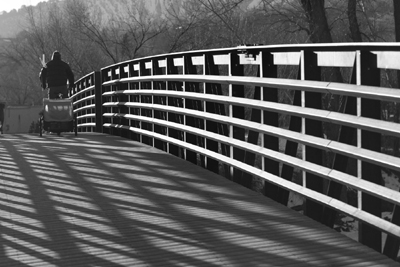|
| ||
| Reducing the carbon footprint SideStory: Top things you can do to reduce your impact
by Missy Votel As other similarly sized cities grapple with ways to reduce their carbon footprint, Durango officials say the city is making headway in its pursuit to reduce greenhouse emissions. Last October, Durango City Council signed the U.S. Mayors Climate Protection Agreement, joining 369 other municipalities across the country, including: Aspen; Basalt; Frisco; Steamboat Springs; Telluride; Park City, Utah; and Jackson, Wyo. The pact calls for meeting or beating the Kyoto Protocol target of reducing greenhouse gas emissions by 7 percent below 1990 levels by the year 2012. The city’s progress comes, in part, from energy-efficient policies that already are in place, said Durango Director of Public Works Jack Rogers. “A lot of these things have been ongoing,” he said, pointing to such things as the introduction of electric-hybrid vehicles in the city’s fleet and the recycling of 35 percent of the city’s waste stream last year. However, Rogers said many changes are being enacted to help meet the goal, particularly in the city’s new Comprehensive Plan. “By far, the Comp Plan contains more policies geared toward energy efficiency and the greening of the community.” The newly released draft of the Comp Plan calls for land-use policies that reduce sprawl and encourage “walkable communities,” he said. Furthermore, it calls for conservation of natural resources through expanded recycling efforts; increased use of recycled products; strategies to reduce waste flow; and providing education on recycling and conservation. Rogers said the Climate Protection pact specifically outlines several areas where cities can make changes to reduce emissions. On the energy consumption side of the equation, Rogers said the city is inventorying its energy usage in conjunction with La Plata Electric Association. The city will use the information to help determine its baseline consumption and areas where it can cut back. Likewise, the city also is increasing its use of clean, alternative energy, such as that from solar and wind. The city also is looking to increase the fuel efficiency of its municipal fleet by adding police vehicles that can run on “E85” – an ethanol-gasoline blend. Such vehicles, while high performing, emit far less greenhouse gases than traditional gasoline engines and consume fuel from a renewable source, mostly corn. Rogers said the city will continue to use biodiesel in its diesel fleet when feasible. He noted that during the winter months, the fuel is not an option because cold temperatures cause it to coagulate. “During the months of March to October, we will use the biodiesel, but it becomes more difficult in the winter months,” he said. In addition to improving energy efficiency in vehicles, Rogers said the city is looking to increase the energy efficiency of new buildings. It is estimated that more than 50 percent of energy consumed in the United States goes to the heating and lighting of buildings. In an effort to offset this, the city will pursue Leadership in Energy and Environmental Design, or LEED, standards in new construction. The widely recognized LEED certification, a mark of a building’s sustainability, is overseen by the nonprofit U.S. Green Building Council. “We’ll be using the green building LEED program on the new library and the police substation by the new Mercy hospital,” Rogers said. Furthermore, every appliance bought for the new library, from heating equipment to microwave ovens, will be energy-star rated, he said. The city is also looking to citizens to do their part in helping meet the 2012 goal. As such, work will continue in 2007 on extending the Animas River Trail from the Durango Mall to the new Rivera Bridge, behind Home Depot, said Durango Director of Parks and Recreation Cathy Metz. In 2007, Metz said the city plans to design the section of trail behind Wal-Mart and to build a pedestrian bridge upstream from the existing Highway 160/550 High Bridge. There are also plans in the next few years to realign the section of trail behind Albertson’s and extend the ART beyond 32nd Street to the northern city limits near the Iron Horse. She also said that soon residents can expect to see bike lanes and a trail along Goeglein Gulch Road. Residents can also do their part by recycling, in traditional and not-so traditional ways, Rogers said. The city is looking to boost its waste recovery rates even more by courting more commercial customers for its recycling pick-up program and by adding more public recycling drop-off sites. In addition, residents will be doing their part to recycle without even knowing it, he said. “We just got $400,000 for a project to recover wastewater plant methane to be scrubbed and sold or burned to produce electricity,” Rogers said. “We’re looking at a few options.” The city already captures methane at the plant and reuses it in the plant’s boilers, he said. By enacting such changes, Rogers said the city hopes to send a message not only to local residents, but to state and national leaders, as well. “The message is, ‘We urge you to do good, and this is what we’re going to do to help.’” •
|
In this week's issue...
- December 18, 2025
- Let it snow
Although ski areas across the West have taken a hit, there’s still hope
- December 18, 2025
- Look, but don't take
Lessons in pottery theft – and remorse – from SW Colorado
- December 11, 2025
- Big plans
Whole Foods, 270 apartments could be coming to Durango Mall parcel


